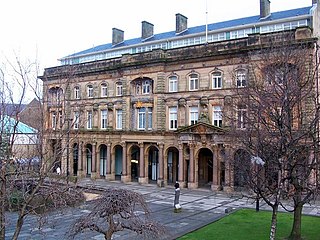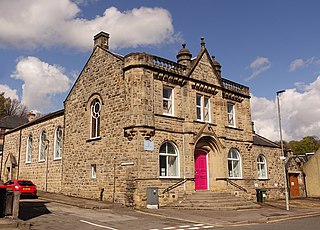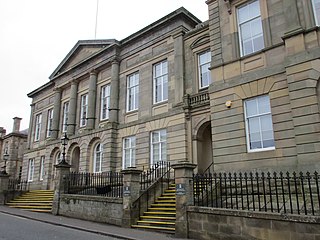
Argyll and Bute is one of 32 unitary council areas in Scotland and a lieutenancy area. The current lord-lieutenant for Argyll and Bute is Jane Margaret MacLeod. The administrative centre for the council area is in Lochgilphead at Kilmory Castle, a 19th-century Gothic Revival building and estate. The current council leader is Councillor Jim Lynch.

Dunoon is the main town on the Cowal Peninsula in the south of Argyll and Bute, west of Scotland. It is located on the western shore of the upper Firth of Clyde, to the south of the Holy Loch and to the north of Innellan. As well as forming part of the council area of Argyll and Bute, Dunoon also has its own community council. Dunoon was a burgh until 1976.

Lochgilphead is a town and former burgh in Argyll and Bute, Scotland, with a population of around 2,300 people. It is the administrative centre of Argyll and Bute Council. The village lies at the end of Loch Gilp and lies on the banks of the Crinan Canal. Lochgilphead sits on the A83, with Ardrishaig 2 miles (3 km) to the south and Inveraray 24 miles (39 km) to the north-east; Oban lies 37 miles (60 km) north on the A816.

Inveraray Jail is a former prison and courthouse in Church Square, Inveraray, Argyll and Bute, Scotland. It was built in 1820 and is a Category A listed building. The prison closed in 1889 but the building remained in use as a courthouse until the mid-twentieth century, in which time it was also used for some meetings of Argyll County Council. Since 1989 it has been a museum.

Oban is a resort town within the Argyll and Bute council area of Scotland. Despite its small size, it is the largest town between Helensburgh and Fort William. During the tourist season, the town can have a temporary population of up to over 24,000 people. Oban occupies a setting in the Firth of Lorn. The bay forms a near perfect horseshoe, protected by the island of Kerrera; and beyond Kerrera, the Isle of Mull. To the north are the long low island of Lismore and the mountains of Morvern and Ardgour.

The Mod Cup, also known as the Aviemore Cup1995 - Royal National Mòd Programmes and fringe events > Royal National Mòd Programmes > [Mod / Mòd Naìseanta Rìoghail - An Comunn Gaidhealach - National Library of Scotland] is a trophy in the sport of shinty first competed for in 1969, traditionally played for by the two teams who are based closest to the host venue of the Royal National Mod. The current holders are Aberdour.(2022)

Dunoon Burgh Hall is a municipal building in Argyll Street, Dunoon, Scotland. The structure, which is used as an events venue, is Category B listed.

Greenock Municipal Buildings is a municipal structure in Clyde Square, Greenock, Scotland. The municipal buildings, which are the headquarters of Inverclyde Council, are Category A listed.

Rothesay Town Hall and County Buildings is a former municipal building in Castle Street, Rothesay, Scotland. The structure, which was the meeting place of Rothesay Burgh Council and of Bute County Council, is a Category B listed building.

The Municipal Buildings are based on the north side of Princes Street East in Helensburgh, Scotland. The structure, which served as the meeting place of Helensburgh Burgh Council, is a Category B listed building.

Campbeltown Town Hall is a municipal structure in Main Street in Campbeltown, Argyll and Bute, Scotland. The structure, which is used as a community events venue, is a Category B listed building.

Cove Burgh Hall is a municipal structure in Shore Road in Cove, Argyll and Bute, Scotland. The structure, which is used as a community events venue, is a Category B listed building.

Sanquhar Tolbooth is a municipal building in the High Street in Sanquhar, Dumfries and Galloway, Scotland. The structure, which accommodates a local history museum, is a Category A listed building.

Dreel Halls is a municipal complex in Elizabeth Place, Anstruther Wester, Fife, Scotland. The complex, which is used as a community events venue, consists of the former St Nicholas's Parish Church, which is a Category A listed building, and the former Anstruther Wester Town Hall, which is a Category C listed building.

Invergordon Town Hall is a municipal building in the High Street in Invergordon in the Highland area of Scotland. The structure, which is used as a community events venue, is a Category B listed building.

Lossiemouth Town Hall is a municipal building in the High Street in Lossiemouth, Moray, Scotland. The building is currently used as a community events venue.

Grant Hall, formerly Rothes Town Hall, is a municipal building in New Street, Rothes, Moray, Scotland. The structure is currently used as a community events venue.

Lanark Sheriff Court is a judicial building in Hope Street, Lanark, South Lanarkshire, Scotland. The building, which continues to serve as the local courthouse, is a Category B listed building.

Ardrossan Civic Centre is a municipal building in Glasgow Street in Ardrossan, a town in North Ayrshire, Scotland. The building, which was previously the offices and meeting place of Ardrossan Burgh Council, is currently used as a masonic hall.

Oban Sheriff Court is a judicial building on Albany Street in Oban in Scotland. The building, which remains in use as a courthouse, is a Category B listed building.





















